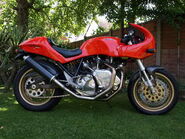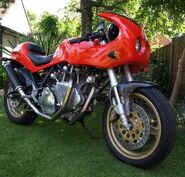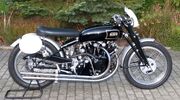
Vincent Black Lightning racer
Vincent Motorcycles was a British manufacturer of motorcycles from 1928 to 1955. Their 1948 Black Shadow was at the time the world's fastest production motorcycle.[1] In 1955 the company discontinued motorcycle production after experiencing heavy financial losses.
History[]
Vincent Motorcycles, "the makers of the world's fastest motorcycles", began with the purchase of HRD Motors Ltd less the factory premises, by Phil Vincent in May, 1928.
HRD was founded by the British Royal Flying Corps (RFC) pilot, Howard Raymond Davies, who was shot down and captured by the Germans in 1917. Legend has it that it was while a prisoner of war that he conceived the idea of building his own motorcycle, and contemplated how he might achieve that. It was not until 1924 that Davies entered into partnership with E J Massey, trading as HRD Motors. Various models were produced, generally powered by JAP (JA Prestwich Industries) engines.
Unfortunately, although HRD motorcycles won races, the company ran at a loss. In January 1928 it went into voluntary liquidation. The company was initially bought by Ernest Humphries of OK-Supreme Motors for the factory space, and the HRD name, jigs, tools, patterns, and remaining components were subsequently offered for sale again.
Phil Vincent[]
- Main article: Phil Vincent
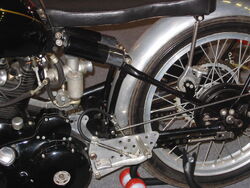
Detail of Vincent cantilever suspension
Philip Vincent was advised to start production under an established name. He had built a motorcycle of his own in 1927 and in 1928 had registered a patent for a cantilever rear suspension of his own design. With the backing of his family wealth from cattle ranching in Argentina, Vincent acquired the trademark, goodwill and remaining components of HRD from Humphries for £450 in 1928.
The company was promptly renamed Vincent HRD Co., Ltd and production moved to Stevenage. The new trademark had "Vincent" in very small letters above "HRD" written large. After World War 2 Britain had an export drive to repay its war debts, and the USA was the largest market for motorcycles, so in 1949 the HRD was dropped from the name to avoid any confusion with the "HD" of Harley Davidson, and the motorcycle became The Vincent.
In 1928 the first Vincent-HRD motorcycle used a JAP single-cylinder engine in a Vincent-designed cantilever frame. The earliest known example extant exists in Canberra, Australia. Some early bikes used Rudge-Python engines. But after a disastrous 1934 Isle of Man TT, with engine problems and all three entries failing to finish, Phil Vincent and Phil Irving decided to build their own engines.
Phil Vincent also experimented with three wheeled vehicles, amphibious vehicles, and cars. In 1932 the first 3-wheeler, "The Vincent Bantam" appeared, powered by a 293cc Villiers engine. It was a 2.5 cwt delivery van with a car seat and a steering wheel. The Bantam cost £57-10-0 and the windscreen and hood option cost £5-10-0. Production ceased in 1936.[2]
Phil Irving[]
- Main article: Phil Irving
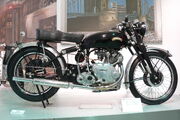
Vincent Comet from 1950 at the Zweirad-Museum Neckarsulm
In 1931 Phil Irving joined Vincent as chief engineer.[3] His first engine design was an OHV 500 cc single-cylinder engine in 1934 called the "Meteor".
World War II[]
In 1937 Phil Irving went to work for Velocette but returned to Vincent Motorcycles in 1943. Vincent primarily made munitions, but Vincent engines were trialled in boats and portable pumps during the war, and the end of hostilities saw Vincent ready to return to motorcycle production.
Vincent already looked to America for sales, and in 1944 Eugene Aucott opened the first USA dealership in the city of Philadelphia. Others followed.
Models[]
- See also: List of Vincent motorcycles
Meteor and Comet[]
The standard motor was known as the Meteor and the sports motor was the Vincent Comet; it was distinguished from earlier Vincent models of that name by the “Series-A” prefix. There was a TT replica & the Comet Special (basically a TTR with lights, horn etc.), which used a bronze head.[4] The Meteor motor produced 26 bhp (19 kW) @ 5300 rpm,
An unusual feature of the valve design for these motors was the double valve guides, and the attachment of the forked rocker arm to a shoulder between the guides, to eliminate side forces on the valve stem and ensure maximum valve life under racing conditions.
The Series-A Comet could do 90 mph (140 km/h), but Phil Vincent and his racing customers wanted more.
1936 Series A Rapide[]
- Main article: Vincent Rapide
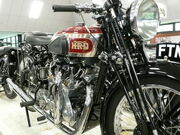
Vincent Series 'A' Rapide
Legend has it that Irving accidentally put a side-view tracing of the Vincent 500 motor wrong way up on top of an equally sized drawing of the same view of the same motor, and saw, moving the tracing so the crankshafts and idler gears coincided, that the result looked like a possible design for a V-twin. This resulted in the 47.5° V twin which appeared in 1936. (The single leaned forward 23.75°.)[5]
With 6.8:1 compression, it produced 45 bhp (34 kW).
The Vincent V-twin motorcycle incorporated a number of new and innovative ideas, some of which were more successful than others.
The Vincent HRD Series A Rapide was introduced in October 1936. Its frame was of brazed lug construction, based on the Comet design but extended to accommodate the longer V twin engine. It continued the use of "cantilever" rear suspension, which was used on all Vincents produced from 1928 through 1955. Other innovations included a side stand.
Pneumatic forks were not to be a Vincent innovation, with both Phils believing girder forks were superior at the time. The Series-A had external oil lines and a separate gearbox.
The 998 cc Series A Rapide Vincent cost $600, produced 45 hp (34 kW), and was capable of 110 miles per hour (180 km/h).
The high power meant that the gearbox and clutch did not cope well.[6]
Specifications[]
- Engine – 998 cc, 47.5 degree v-twin ohv four-stroke
- Bore and Stroke – 84 x 90 mm
- Compression Ratio – 6.8:1
- Power – 45 bhp (34 kW) @ 5500 rpm
- Produced – 1936–1939
- Wheelbase – 58.5 inch
- Dry Weight – 430 lb (200 kg)
- Carburettor – 1.0625 inch Amal
- Gearbox – Burman 4 speed, triplex chain primary, wet multiplate clutch
- Frame – Brazed lug duplex tubular cradle. Cantilever rear springing
- Front forks – Brampton girder forks
- Top Speed – 110 mph (180 km/h)
1946 Series B Rapide[]
The Series B Rapide designed during the war and released to the press before end of hostilities looked radically different from the A: now the oil pipes were internal, and the gearbox was part of the engine casting (Unit Construction). The angle between the cylinders was now 50° instead of the 47.5° of the Series A engine. This allowed the use of the engine as a stressed member of the frame, which consisted of an oil-tank spine with the engine hanging below, and the front and rear suspension attached at the ends. This was considered sensational at the time, and the arrangement was not seen again till the late seventies. The use of the engine-gearbox unit as a stressed member became more usual. Brakes were dual single-leading shoe (SLS), front and rear. The 55.5-inch (1,410 mm) wheelbase was three inches (76 mm) shorter than the Series A, and its dimensions were more like a 500 cc bike of the time.
A more modern hydraulic shock absorber and spring assembly later replaced the old twin springs and friction damper. The rear seat was supported by a sub-frame down to the rear frame pivot point, providing a semi-sprung seat with 6 inches (150 mm) of suspension. (Yamaha would rediscover this suspension system nearly 40 years later.)
The Series B had a Feridax Dunlopillo Dualseat, and a tool tray under the front.[7]
The Series "B" incorporated an inline felt oil filter instead of the metal gauze of the Series "A".
Vincent used quickly detachable wheels, making wheel and tyre changes easier. The rear wheel was reversible, and different size rear sprockets could be fitted for quick final-drive ratio changes. The brake & gear shift were adjustable for reach to suit individual feet. The rear mud guard was hinged to facilitate the removal of the rear wheel.
From today's perspective, it seems incongruous that Vincent could see the need for, and design, a cantilever rear suspension, as well as incorporate so many other new ideas, yet use Brampton girder forks with friction dampers up front. The two Phils felt that the telescopic forks of the time were prone to lateral flex, so they persisted with girder forks, and did use hydraulic damping in the Series C "Girdraulic" forks.
Starting in 1948, Indian Motorcycles distributed Vincents in the United States along with other British motorcycles including AJS, Royal Enfield, Matchless and Norton Motorcycle Company.[8] That same year an Indian Chief was sent to Stevenage to be fitted with a Vincent Rapide engine. The resulting hybrid Vindian did not go into production.
1948 Series C Vincents, "Black Shadow" and "Black Lightning"[]

Vincent Black Lightning from 1950 at the Zweirad-Museum Neckarsulm
The 1948 Series C Rapide differed from the Series B in having "Girdraulic" front forks – which were girder forks with hydraulic damping.[9] By 1950, the Series C featured a 998cc, 50-degree V-twin that put out between 45 and 55 horsepower, depending on the state of tune (Rapide or Black Shadow).[10]
The Black Shadow, capable of 125 mph (201 km/h), and easily recognised by its black engine and gearbox unit, and large 150 mph (240 km/h) speedometer, was introduced. The engine produced 54 bhp (40 kW) @ 5700 rpm in Black Shadow trim.
The Black Lightning was a racing version of the Black Shadow; every necessary steel part on it that could be was remade in aluminium, and anything not essential was removed altogether. These changes helped reduce the weight from 458 lb (208 kg) to 380 lb (170 kg). Every bit the racer, it had a single racing seat and rear-set footrests.
The 500 cc Meteor and Comet singles were introduced, along with a 500 cc racer, the Vincent Grey Flash. The Grey Flash racer used Albion gears, for the greater choice of ratios available.[11] The 500 cc bikes used a wet multiplate clutch, while the 998 cc V-twins used a dry, drum-type servo clutch.
Most Vincents were painted black. In 1949 a White Shadow (a machine to Black Shadow mechanical specification, with the Rapide colour scheme) was available, but only 15 were sold, and the option was dropped in 1952. In 1950 16 Red Comets were shipped to the United States. There were also 31 of the 1948 Grey Flash built.[12]
From 1949 HRD was dropped from the name, and the logo now simply read "Vincent".
Specifications[]
- Make: Vincent HRD
- Model: 1948 Series C Black Shadow
- Engine: 998 cc (84 x 90 mm bore and stroke) 50° OHV V Twin, 7.3:1 CR, polished conrods
- Carburetor: 2 x 1.125-inch (28.6 mm) type 29 Amals
- Ignition: Lucas Magneto (1955 models: Kettering ignition)
- Electrics: 6v 45w dynamo
- Lubrication: Dry sump, 3 US quarts
- Gearbox: Integral Vincent four speed, triplex chain primary, dry servo – drum clutch
- Final Drive: 530 chain, 46/21 sprockets
- Tyres: 3 x 20 in front, 3.50 x 19 in rear
- Wheels: Front: 1.65 x 20 in. steel rim; Rear: 1.65 x 19 in. steel rim.
- Frame: Spine frame with engine as stressed member
- Rear Suspension: Cantilever rear springing
- Front forks: Vincent Girdraulic forks, 3" travel
- Brakes: Twin drums, 7 in diameter in front and rear, single leading shoe 7/8" wide.
- Weight: 458 lb (208 kg) – 206 kg Wet – 500 lb (227 kg)
- Wheelbase: 55.5 in. (1415 mm)
- Seat height: 32.5 in. (826 mm)
- Performance: 125 mph / 201 km/h – 55 bhp (41 kW) at 5500 rpm
- Fuel Capacity 3.5 gallons / 16 litres
- Manufacturer: The Vincent-HRD Co. Ltd., Great North Road, Stevenage, Herts
1954 "Series D" Vincents[]
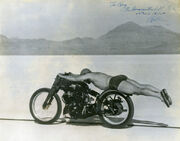
Vincent power land speed record holder Rollie Free featured in one of the most iconic photographs in motorcycling history.
The term "Series D" was not used by the factory, but was taken as a natural progression by the motorcycling world. With sales falling, Vincent tried building two new high-speed touring models; the fully enclosed Vincent Victor (an upgraded Comet), the Black Knight (an upgraded Rapide) and the Vincent Black Prince (an upgraded Shadow). They were poorly received by the public. A short-lived unfaired version of the Black Prince was then produced. There was still a Series D Comet.
Rolland "Rollie" Free (November 11, 1900 – October 11, 1984) was a motorcycle racer best known for breaking the American motorcycle land speed record in 1948 on the Bonneville Salt Flats, Utah. The picture of Free, prone and wearing a bathing suit, has been described as the most famous picture in motorcycling [13] and Russell Wright won another World Land Speed Record at Swannanoa with a Vincent HRD motorcycle in 1955 at 184.83 mph (297.46 km/h).
However, sales declined further after the post war motorcycling boom owing to the availability of cheaper motor cars, so not many "Series D" models were made.
Fireflys, Three Wheelers, and NSU[]
The Firefly was a 45 cc "clip on" engined bicycle built from 1953 to 1955 under licence from Miller, who were suppliers of electrical components to Vincent. It was also known as the Vincent Power Cycle. The Vincent Owners Club was predictably surprised by this new, cheap, entry-level Vincent.[14]
By 1954, Vincent Motorcycles was in an increasingly difficult situation. In the quest for solvency, Vincent looked for ways to improve their position. The trike idea was revived. In 1932 "The Vincent Bantam" was first introduced: Vincent's first 3-wheeler, powered by a 293 cc SV JAP or 250 cc Villiers engine, was a 2.5 cwt delivery van which used a car seat and steering wheel rather than the standard motorcycle saddle and handlebars. The Bantam was priced at £57-10-0 with a windscreen and hood available for an additional £5-10-0. It ceased production in 1936 – the first year of the Series A motorcycle.
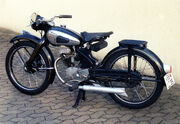
NSU-Vincent Fox
In 1954/1955, due to falling sales of motorcycles, the prototype 3-wheeler powered by a Vincent Rapide 998 cc engine was produced. (Some years later,the vehicle was named "Polyphemus" by its owner, Roy Harper.) To keep development and production costs low, it used a parts bin-approach, including pieces from Vincent motorcycles, as well as wheels which came from a Morris Minor. The body was made from 16-gauge aluminium. With the standard Rapide engine, "Polyphemus" could reach 90 mph (140 km/h). Before it was sold, in the hands of Ted Davis, it achieved 117 mph (188 km/h) with a Black Lightning engine. The “Vincent 3-wheeler” was eventually sold to a member of the public for £500 – a high price for any vehicle at the time (the BMC Mini launched four years later for £497[15]), especially for a vehicle with no reverse gear, self starter or hood.[2]
Unfortunately Vincent motorcycles were hand-built and expensive – only a total of 11,000 machines were sold post-World War Two. A sales slump in 1954 forced the company to import and sell NSU mopeds. 160 two-stroke Foxes NSU-Vincent 123 cc were built. There were also 40 98cc OHV four-stroke NSU-Vincents, and Vincent also sold the "NSU Quickly" moped; too well it appears (selling about 20,000 in one year – a foot note to how the market had changed again), as NSU took control of its own sales after a year.
The Last Vincent Motorcycle[]
At a Vincent Owners' Club dinner in the summer of 1955, Phil Vincent announced that the company could no longer continue in the face of heavy losses and that production of motorcycles would cease almost immediately.[16]
In 1955, one week before Christmas, the last Vincent came off the production line and was promptly labeled "The Last."
Post Motorcycle manufacturing[]
The factory then turned to general engineering, the manufacture of industrial engines, and there was the Amanda water scooter, possibly the first personal watercraft.[17] A Vincent engineer lost his life testing it, drowning at sea.[18]
Vincent tried for a government contract supplying motors for the ML Aviation U120D target aircraft.[19] The motor had to be capable of passing prolonged full power operation tests. This was called the Picador project. The Vincent motor was upgraded with a better crankshaft, Scintilla magneto, double speed oil pump and fuel injection. They did not get a contract. (Russel Wright's record breaking bike was fitted with a Picador crank and oil pump, by Vincent, while in England for Earls Court, shortly after the 1955 record attempt.)[20]
The company went into receivership in 1959. It has since been bought and sold by other engineering firms. In 1955 Phil Vincent declared that Vincent parts would always be available.[citation needed]
Subsequent developments[]
Vincent engines have been fitted to other frames. The most obvious is the Norvin, using a Norton Featherbed frame, with or without the lower frame tubes. The Norvin is made in the UK by Hailwood Motorcycle Restorations [21] Specialist frame manufacturers also made frames for the Vincent engine.
Fritz Egli[]
- Main article: Fritz Egli
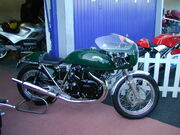
Egli Vincent
Fritz Egli, a specialist frame manufacturer based in Switzerland, produced an Egli-Vincent, and around 100 were produced between 1967 and 1972. Egli-Vincents are now being built under licence in France by Patrick Godet.[22] Non authorized copies (by Fritz Egli) are also proposed in the UK by Hailwood Motorcycle Restorations (HMR) and JMR.[23]
Vincent RTV Motorcycles[]
In 1996, a new motorcycle company was formed by two individuals, Terry Prince (well known life long Vincent enthusiast and specialist) and Ron Slender. The company was named RTV Motorcycles. Its ambition was to produce a modern day classic Vincent motorcycle that could be marketed, in reasonable volumes, worldwide. It used a redesigned and modernised version of the Vincent engine, engineered by Terry Prince, with an increased capacity and in an Egli-style frame.The motorcycles were to be built individually by hand.
The range was to include both a touring and sports model in capacities of 1000 cc (RTV1000) and 1200 cc (RTV1200). Complete new engines would also be made available for separate purchase. Production was initially to begin for the larger capacity machine designated the RTV 1200 which produced 85 bhp at 6500 rpm.[24] These were to be fitted, as standard, with state of the art; Bosch electric start, Brembo brakes, adjustable Paiola upside down forks, Ohlins rear monoshock and V-2 multiplate clutch. Only one factory prototype RTV was ever built by Terry Prince, in 1998, before the company went into voluntary liquidation towards the end of that year. After that time the remaining motors (numbering 12 -15) were sold but not all in RTV frames. The original factory prototype, a RTV1200, remains to this day in a private collection in the United Kingdom.[25]
Vincent Motors USA[]
Vincent Motors USA founder and president, Bernard Li, acquired the Vincent trademarks in 1994 and formally launched Vincent Motors USA in 1998 spending about $2 million building prototypes that resemble the original Vincent but utilised modern components like the Honda RC51 V-twin engine. Vincent Motors is based in San Diego.[26] A resurrection of the Vincent name now seems unlikely as the Honda RC51 engine is now out of production, and Li was killed in a motorcycle accident.[27]
See also[]
- List of Vincent motorcycles
- HRD Motorcycles
- Vincent Black Shadow
Notes[]
- ↑ Ward, Ian. Great British Bikes. Macdonald & Co. ISBN 0-7481-0020-2.
- ↑ 2.0 2.1 [1] 3Wheelers Vincent Three Wheelers (Retrieved 22 October 2006)
- ↑ [2] VincentMotors History (Retrieved 22 October 2006)
- ↑ [3] NTNOA Histories (Retrieved 22 October 2006)
- ↑ [4] Dropbears Histories (Retrieved 22 October 2006)
- ↑ [5] IanChadwick Vincent (Retrieved 22 October 2006)
- ↑ [6] TheVincent Models and Fittings (Retrieved 22 October 2006)
- ↑ Greg Williams (September/October 2009). "The Last Vincent Black Lightning?". Motorcycle Classics. Retrieved on 2010-10-27.
- ↑ [7] Is-it-a-lemon Vincent review (Retrieved 22 October 2006)
- ↑ Clement Salvadori (March/April 2007). "Riding the Big Sur on a 1950 Vincent Series C Rapide". Motorcycle Classics. Retrieved on 2010-10-27.
- ↑ [8] The Vincent Grey Flash Information (Retrieved 22 October 2006)
- ↑ Vincent production figures
- ↑ "Rollie Free". AMA Mortorcycle Hall of Fame Museum. Retrieved on 2009-07-10.
- ↑ [9] Globalnet Vincent Firefly (Retrieved 22 October 2006)
- ↑ The History of Mini – MiniWorld
- ↑ [10] VincentMotors History Page3. (Retrieved 22 October 2006)
- ↑ [11] IanChadwick Vincent (Retrieved 22 October 2006)
- ↑ [12] MindSpring 1953 Works Visit (Retrieved 22 October 2006)
- ↑ http://www.flightglobal.com/pdfarchive/view/1953/1953%20-%201102.html
- ↑ [13] The Vincent Picador Drone (Retrieved 22 October 2006)
- ↑ [14] Hailwood Motorcycle Restorations HMR Norvin (Retrieved 3 July 2007)
- ↑ [15] GodetMotorcycles Egli (Retrieved 22 October 2006)
- ↑ [16] Hailwood Motorcycle Restorations HMR Egli-Vincent (Retrieved 22 October 2006)
- ↑ [17] VINCENT RTV 1200
- ↑ [18] UnionJack RTV Vincent (Retrieved 22 October 2006)
- ↑ [19] Vincent Motors San Diego (Retrieved 22 October 2006)
- ↑ [20] Bernard Li, 1946–2008 (Retrieved 11 November 2008)
References[]
- "Vincent HRD Gallery" by Roy Harper. Vincent Publishing Company 1974.
- "The Vincent HRD Story" by Roy Harper. Vincent Publishing Company 1975.
- "P.C.V. The Autobiography of Philip Vincent". Vincent Publishing Company 1976.
- "Vincent: 50 Years of the Marque" by P.C.Vincent. Vincent Publishing Company 1977.
- "Vincent Vee-Twins" by Roy Harper. Osprey Publishing. 1982.
- H.R.D. Motor Cycles. Produced by a Rider Auth: Geoff Preece; Publisher: J. Bickerstaff 1992
- Vincent Motorcycles: The Complete Story, David Wright Pub: Crowood Motoclassics, ISBN 1-86126-516-6 2002.
- Vincent and HRD Motorcycles – How They Were Promoted and Sold', David Wright, Limited edition of 998 copies 2006.
- "The Snarling Beast" by P.C.Vincent. Vincent Publishing Company 2008. ISBN 978-0-905943-20-6
External links[]
- Vincent Motors USA
- Hunter S Thompson article on the Vincent Black Shadow
- Listen to Richard Thompson's song Vincent Black Lightning 1952
- Vincent Motors history, Motorcycledaily.com
| ||||||||
((wikipedia}}

